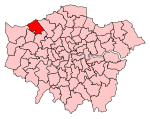Park High School, Stanmore
AC with 0 elementsAcademies in the London Borough of HarrowLondon school stubsSecondary schools in the London Borough of HarrowStanmore
Park High School is a coeducational 11–18 Academy in Stanmore, London, England. It is located next to Centenary Park.The school converted to academy status in 2011, having previously been a community school under the direct control of Harrow London Borough Council. The school continues to coordinate with Harrow London Borough Council for admissions. Park High School offers GCSEs, OCR Nationals and A Levels as programmes of study for pupils.
Excerpt from the Wikipedia article Park High School, Stanmore (License: CC BY-SA 3.0, Authors).Park High School, Stanmore
Thistlecroft Gardens, London Belmont (London Borough of Harrow)
Geographical coordinates (GPS) Address Phone number Website External links Nearby Places Show on map
Geographical coordinates (GPS)
| Latitude | Longitude |
|---|---|
| N 51.59947 ° | E -0.30279 ° |
Address
Park High School
Thistlecroft Gardens
HA7 1PL London, Belmont (London Borough of Harrow)
England, United Kingdom
Open on Google Maps








